The History of Marshmallow Experiment
Origin
- The marshmallow experiment was done by Mischel, and traces back its roots in Trinidad.
- Mischel wanted to find out the reactions of children towards some psychological aspects.
- He found that diverse cultural groups existing in an island had divergent stereotypes namely being funny, careless, and strength of mind.
- It was a study that entailed fifty-three male and female kids aged between seven and nine years.
- Amongst the study participants, eighteen were Indians and thirty-five Negros.
- Michel sought to specify the choice of these children with respect to getting and consuming one candy straight away.
- There were those who waited to have ten sweeties after seven days as rewards for patience.
- Important differences were not seen when comparing low and high socioeconomic groups based on the experimental choice.
This experiment was done by Mischel long back in Trinidad to find out the reactions of children towards some psychological aspects (Mischel, Ebbe and Antonette 215).
- The researcher spotted great age differences as well as cultural differences between early ages, teenage, and adult stages.
- The research aimed at revealing the greater aptitude that existed between children who originated from integral families.
- The integrated families were widespread in African civilized groups, and children from the East Indian groups.
- Children who had no fathers showed the strongest talent to holdup their indulgence during this experiment.
Stanford experiment
- The aim of this study was to investigate the capability to fancy something one might want or build up in a young person.
- The study was conducted at Stanford University and the participants came from Bing Nursery School.
- The study respondents included kids aged four years old.
- Over six hundred children were fielded in a destruction free zone in which marshmallow, pretzel stick or Oreo cookies were put on a table.
The study was conducted in Stanford University at the Bing Nursery School with the clients being kids of age four years old (Mischel, Ebbe and Antonette 209).
- They were permitted to eat the marshmallow, but if they could wait for fifteen minutes without consuming it, they would be given a second marshmallow.
- The researcher by this time analyzed and formulated the reason as to why some children would turn away or wrap up their faces with their hands to avoid facing the plate holding the marshmallow.
- Other children would wallop the marshmallow as minute overfed creatures or even dribble the desk.
- Others would at once eat the marshmallow as soon as the researcher leaves the room or a few seconds later.
- Most of the children who took part in this experiment were anxious and ate their marshmallows immediately.
- Only a third of the total participants delayed their indulgence long enough to wait and obtain the second marshmallow as they were impatient.
- In the experiment, the most important aspect or determinant of late indulgence was age.
- The disparity between the ages remained even at maturity age as argued out by the psychologists.
Today, most scholars use the marshmallow’s research to learn all kinds of skills, as well as incorporating at what time and how to bring into play personal self control (Shoda, Mischel and Peake 981).
- Today, most scholars use the marshmallow research to learn different kinds of skills and assess the time taken by study participants and how to bring in personal self- control into play.
- In the historical context, Walter Michel’s marshmallow assessment remains one of excellent and recognized studies in psychology.
- Researchers such as Kidd who intended to test the trust effectiveness have conducted other related studies.
- The current studies are all based on Michel’s marshmallow experimental research.
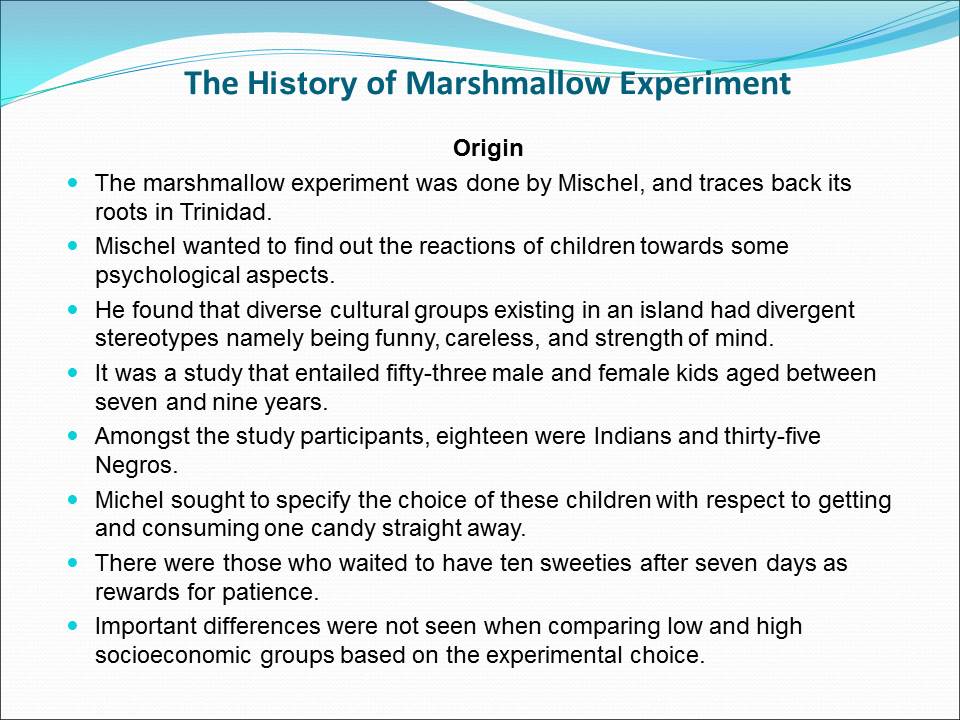
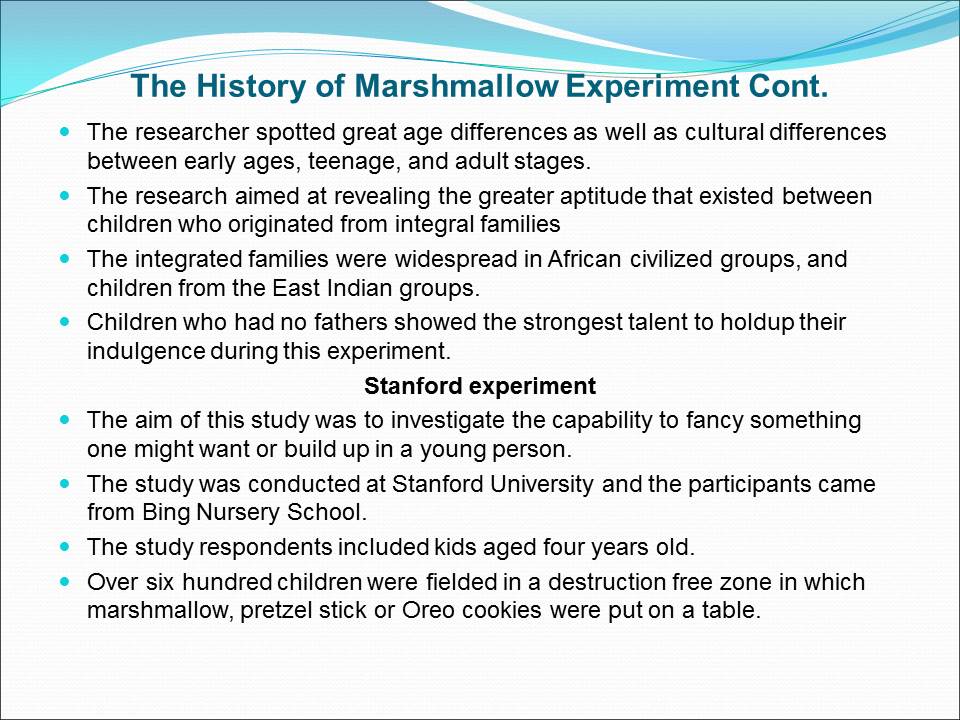
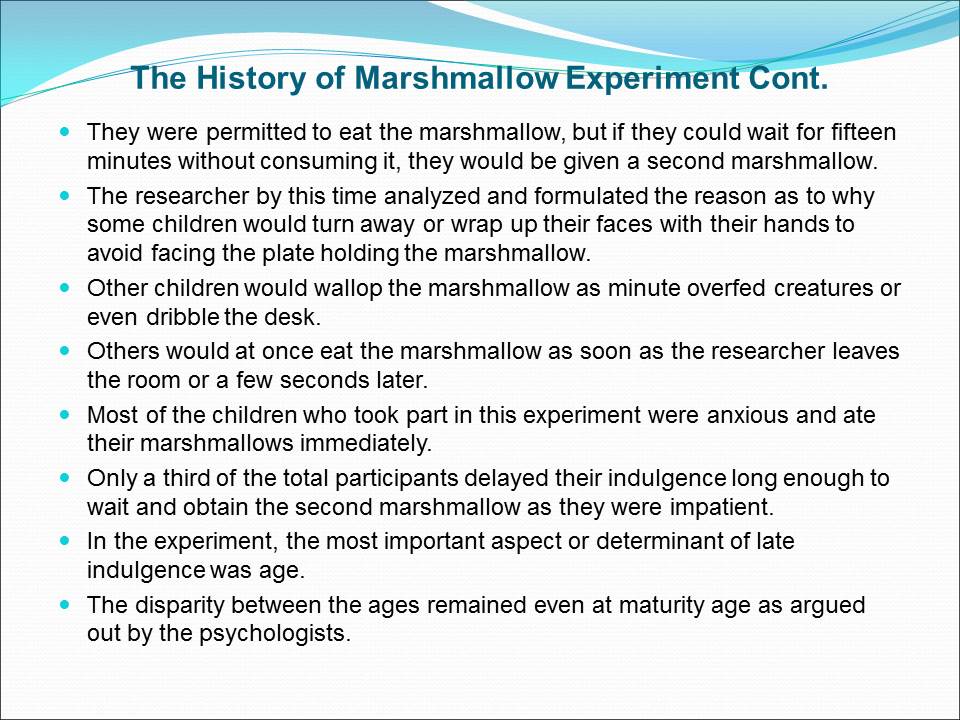
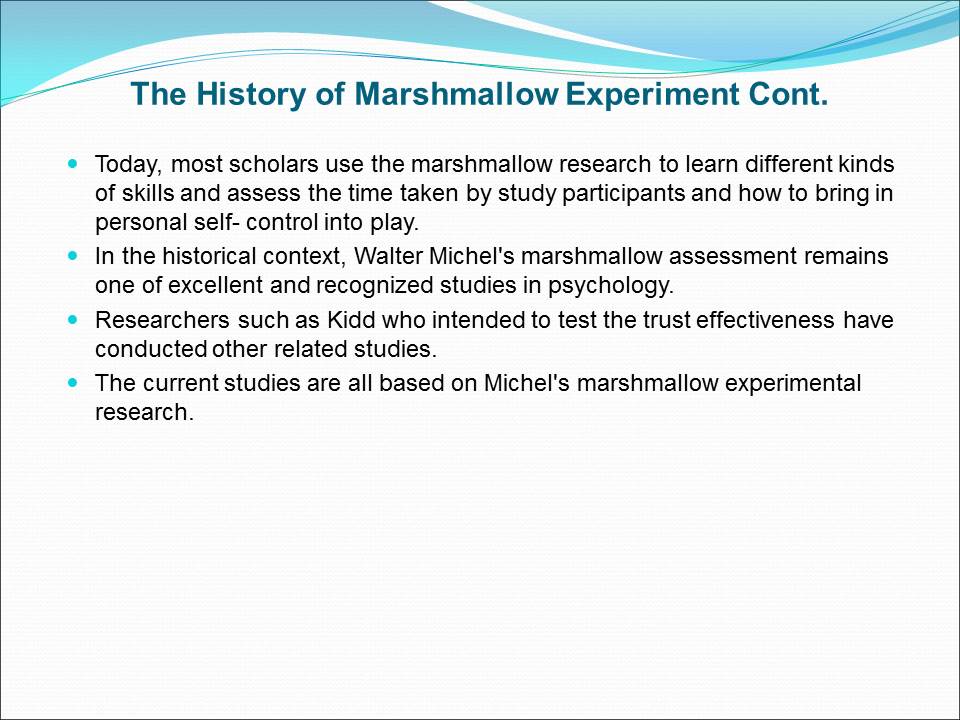
The theory of Marshmallow Experiment
- It is believed that their backgrounds that were full of uncertainty and change shaped up children’s way of response.
- The grit and determination of kids encourage their unitary self-control to expound on early days decisions and future adult outcomes.
- The essence of the delay was only met through influence and making repetitive promises that something worth waiting was to be given to them.
- Children who could not be tolerant and wait were stubborn, irritated and had poor self-admiration.
- Mischel believed that self-motivation means being able to delay gratification and such children were emotionally intelligent and successful in life.
- Children hardly deferred gratification-encountered difficulties in interpersonal affiliations, had low self-respect, and used drugs at the age of thirty years.
- The researcher thought that the emotional hub within the mind of a child who could delay gratification takes fifteen to sixteen years to mature.
- It was thought that young kids at the age of four were hardly in command of them to holdup gratification and were hopeless in a number of ways.
Children who could not defer gratification had bottlenecks with interpersonal affiliation, lower self respect and uses drugs highly when they reach the age of thirty years (Shoda, Mischel and Peake 981).
- Despite the fact that emotional brainpower could be taught, learnt, and understood, it was supposed to occur at the offspring residential areas.
- Knowledge of how, and at what time to use self control and any other interpersonal skills were assumed to be engaged during maturity or at adult stage.
- Mischel, a psychology researcher, theoretical assumed that there was a correlation between individuals’ long-term success and self-discipline or delayed gratification.
- Individuals with the abilities to holdup their gratifications were supposed to have lifelong success.
- By offering the four year old-hungry children marshmallows, it was hypothesized that there were those who lacked delayed gratification, and those with delayed gratification.
- Those with self-discipline could wait for the experimenter to return to be given the second marshmallow.
- Study groups that lacked deferred gratification could start consuming the marshmallow before time elapsed.
Michael Mischel who was a psychology researcher theoretical assumed that there was a correlation between individuals long term success and self discipline or delayed gratification (Shoda, Mischel and Peake 983).
- Children who could wait for 15-20 minutes for the return of the investigator were alleged to demonstrate the abilities to control impulse and delay gratification.
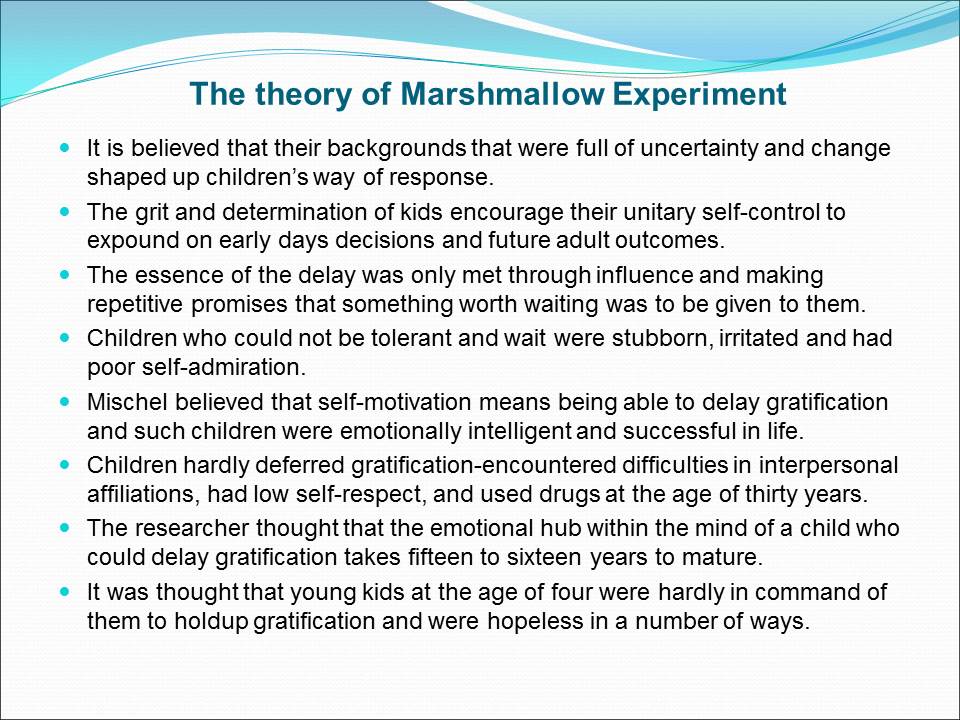
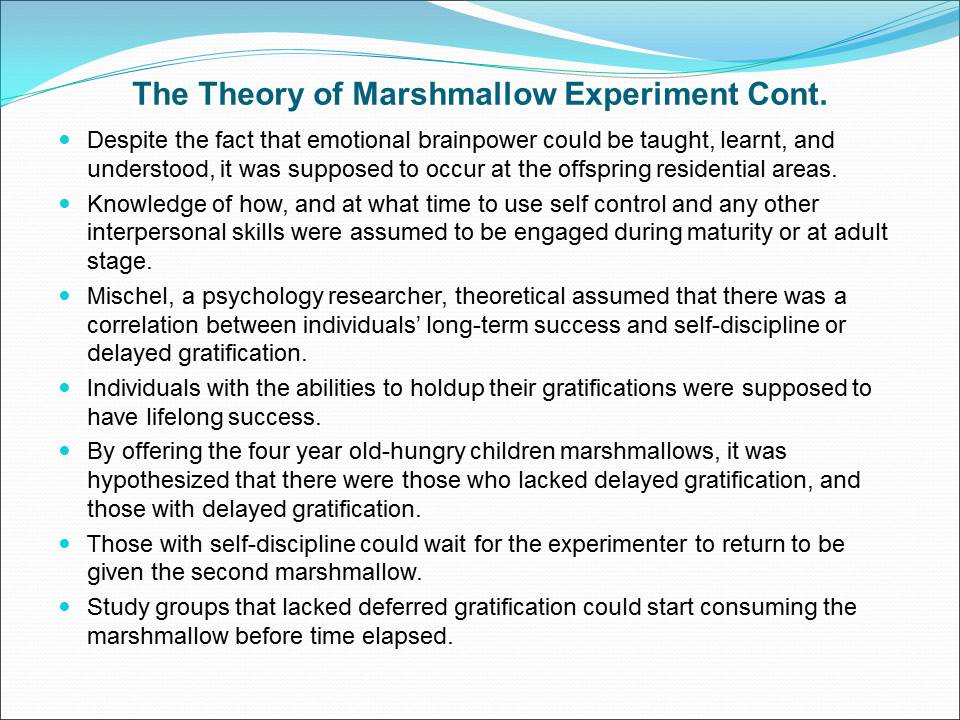
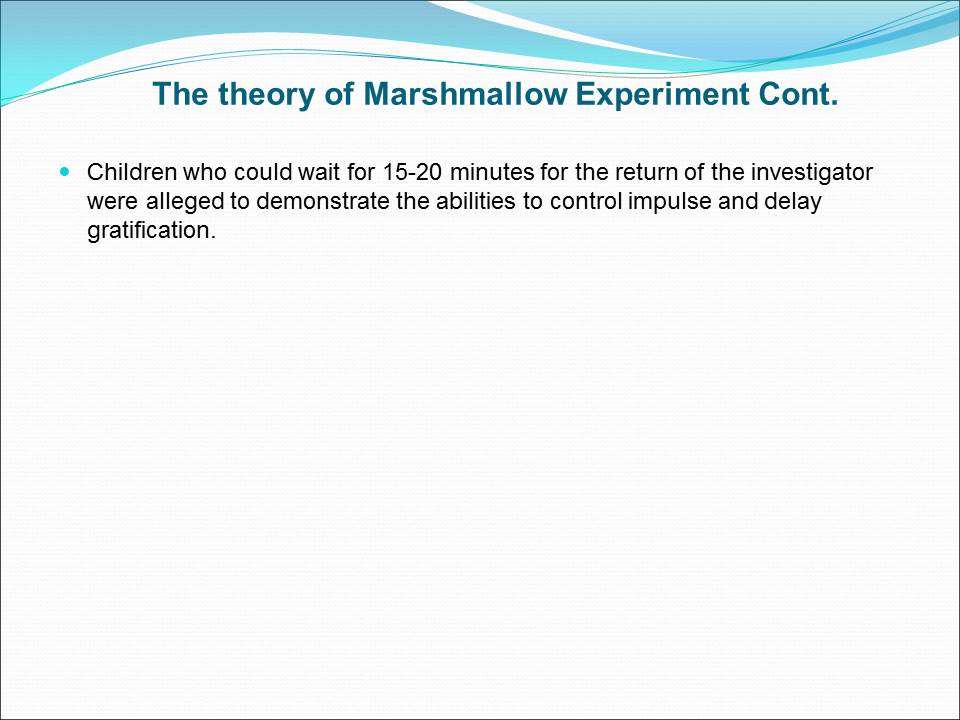
Marshmallow Experiment Hypotheses
The first hypothesis
- The null hypothesis: The age bracket determines the growth of children’s self-discipline or deferred gratification.
- Alternative hypothesis: The age bracket does not determine the growth of children’s self-discipline or deferred gratification.
The second hypothesis
- The null hypothesis (Ho): Children with delayed or deferred gratification experience long life or future success and are able to control their impulses.
- Alternative hypothesis (HA): Children with delayed gratification do not experience long life or future success and are able to control their impulses.
Rejecting and accepting the null or alternative hypotheses
The first hypothesis
- The Stanford marshmallow experiment was a standard assessment of children self-control.
- Children sat around the table where marshmallow was placed before them and were asked not to eat for a time span of fifteen to twenty minutes to be given another marshmallow on top of what they already had.
- From the over six hundred kids who participated in the Stanford test, very few started eating the marshmallow instantly.
- A third of those attempting to delay gratification struggled to be given another marshmallow.
- It was clear that the age brackets determined their delayed gratification since the first one (Ho) holds true while the second hypothesis is untrue.
- The null hypothesis should thus be accepted while the alternative hypothesis rejected.
- From the experiment, the age bracket determined the growth of children’s self-discipline or deferred gratification.
The Second Hypothesis: Accepting the null hypothesis
Years after the study had been conducted high school graduates who participated in that Stanford experiment showed varying results.
Those who resisted consuming the marshmallow immediately to be given the second one were able to defer gratification to pursue their goals, endured difficulties, were self motivating and very positive.
Kids with delayed gratification showed the traits of victorious groups.
People with deferred gratification experienced more fulfilling lives, better health, greater career satisfaction, higher incomes, and successful marriages than those without delayed gratification.
The null hypothesis should thus be accepted since children with delayed or deferred gratification experienced long life or future success and were able to control their impulses.
Rejecting the alternative hypothesis
High school graduates who participated in the Stanford test and grabbed the marshmallow instantly appeared less confident, mistrustful, indecisive, stubborn, troubled, and failed defer their gratification.
They could not realize their long-term goals through subordinating their instant impulses.
Children who could not delay gratification were abstracted during examination time by activities that necessitated immediate gratification.
They were accompanied by those impulses all through lives resulting into frustrating lives, bad health, low income, low job satisfaction, and unsuccessful marriages.
The alternative hypothesis should thus by rejected since children with delayed or deferred gratification do not experience long life or future success and are unable to control their impulses.
Conclusion
From the marshmallow experiment that was carried out by Mischel, it is apparent that the study began in the fiscal 1960s.
It was a longitudinal research conducted using four year old hungry kids who came from Bing kindergarten school.
Marshmallow was placed before these kids to determine which kids could delay their gratification for fifteen to twenty minutes.
The study participants who could defer there gratification were promised an additional marshmallow.
The study results showed that only a third of the kids opted to grab the marshmallow immediately Mischel left the room.
The group that managed to control their impulses and defer their gratification later proved to be successful in all their endeavors.
The group that hardly managed to control their impulses and defer their gratification later proved to be successful in all their endeavors.
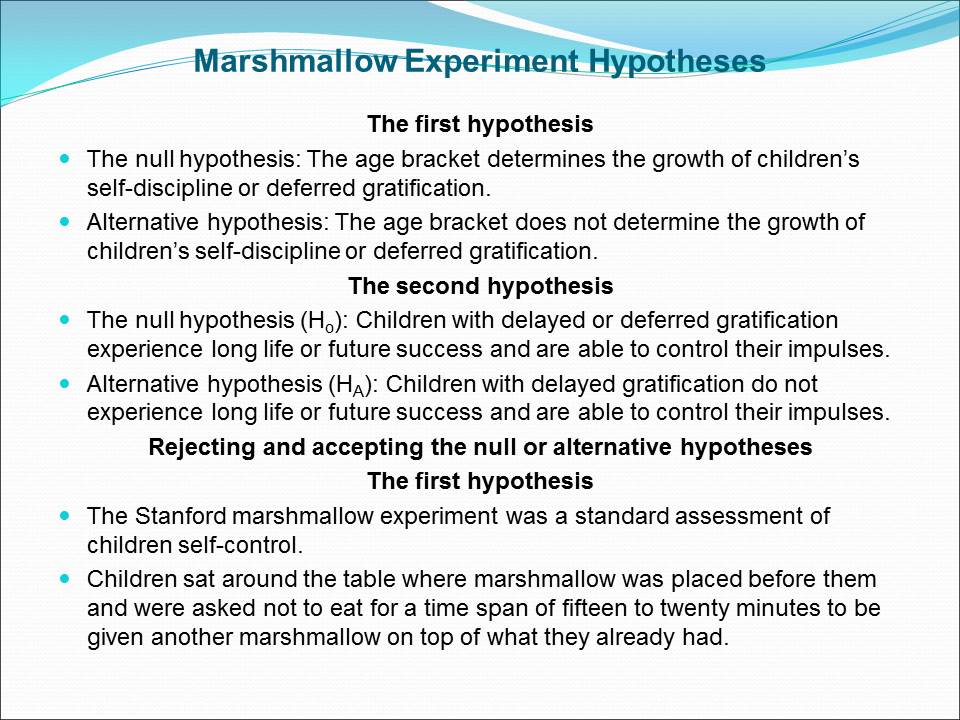
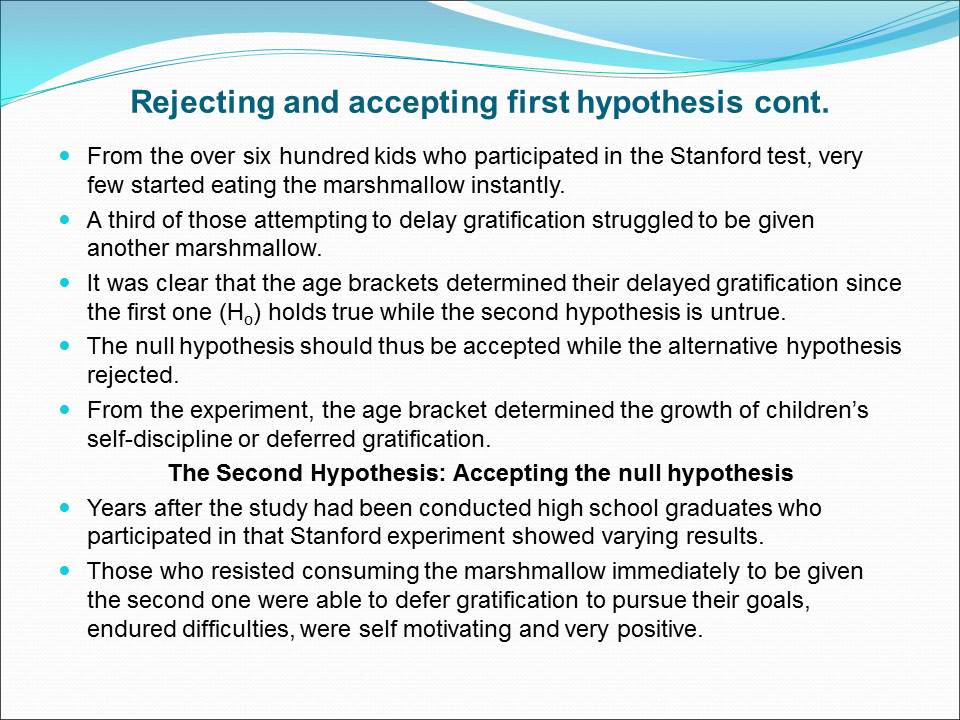
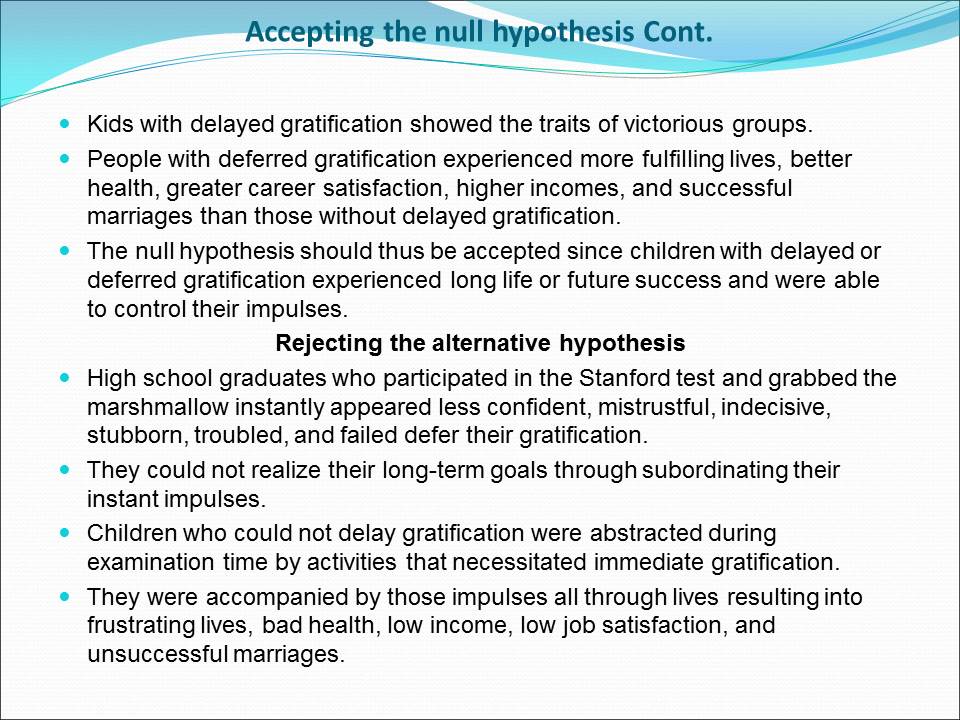
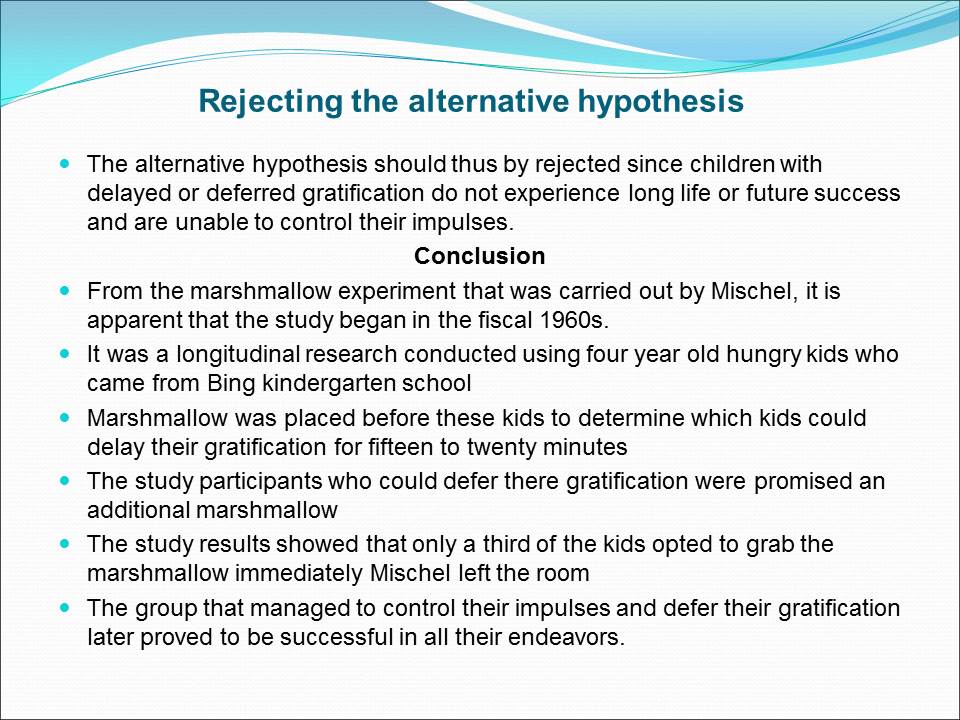
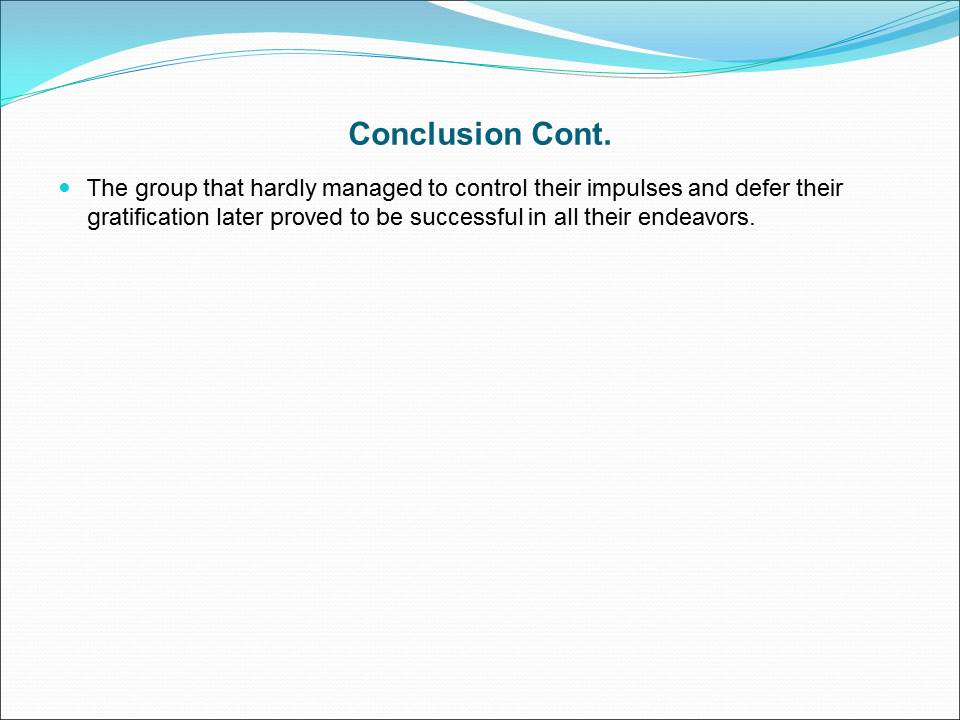
Works Cited
Mischel, Walter, Ebbe Ebbesen and Antonette Raskoff. “Cognitive and Attentional Mechanisms in Delay of Gratification.” Journal of Personality and Social Psychology, 21.2 (1972): 204–218. Print.
Mischel, Walter. “Preference for Delayed Reinforcement: An Experimental Study of a Cultural Observation.” The Journal of Abnormal and Social Psychology, 56 (1958): 57-61. Print.
Shoda, Yuichi, Walter Mischel and Philip Peake. “Predicting Adolescent Cognitive and Self-Regulatory Competencies from Preschool Delay of Gratification: Identifying Diagnostic Conditions.” Developmental Psychology, 26.6 (1990): 978–986. Print.